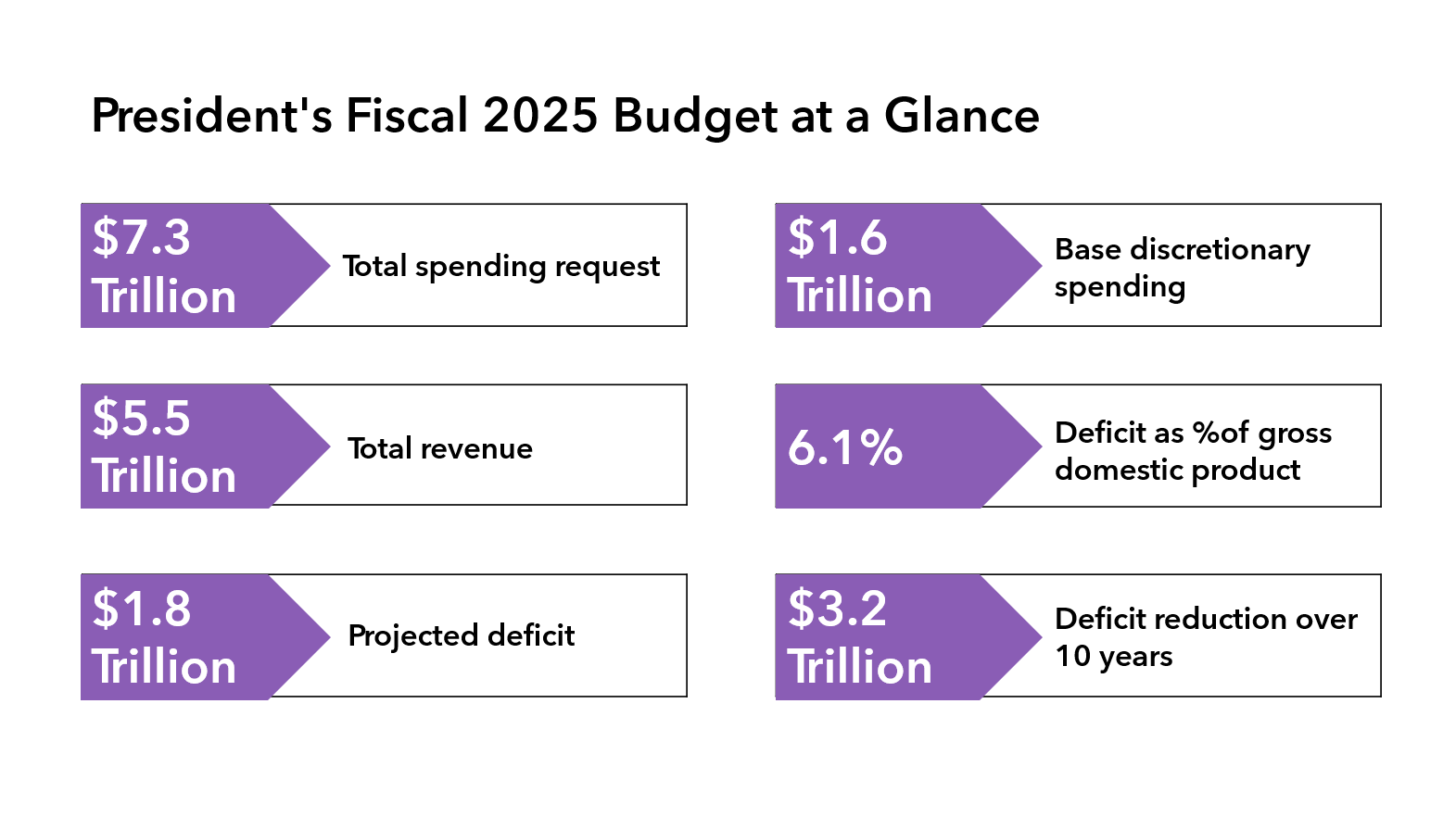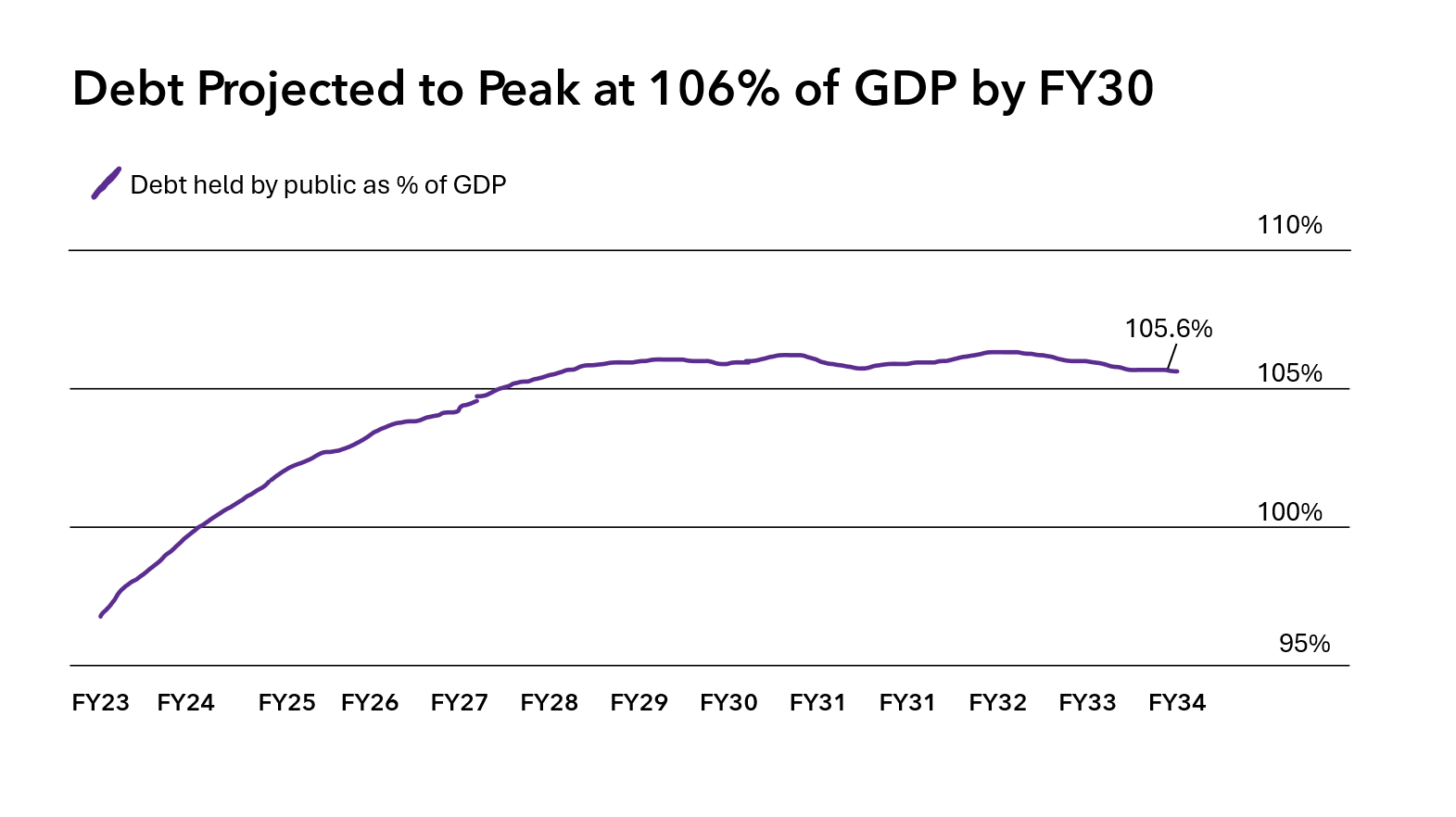The President’s FY25 Budget Request
On March 11, 2024, President Joe Biden released a $7.3 trillion budget request for FY25. $4.3 trillion would be allocated for mandatory spending programs – Social Security, Medicare, and Medicaid – and $1.6 trillion would go toward discretionary expenses, including $895 billion for defense and $770 billion for nondefense spending and emergency funds.As called for in his State of the Union address, President Biden intends to increase tax revenue by implementing a 25% minimum tax on billionaires and raising the top corporate tax rates to 28% from 21%. Though these tax proposals stand very little chance of advancing in Congress or becoming law, his budget request serves as a political document laying out his agenda for next term if elected.

How does the FY25 budget proposal address the federal debt?
Through his proposed tax changes, Biden’s administration plans to raise revenue to decrease the annual deficit as a share of GDP steadily over the next decade. In the coming years, the federal debt is projected to rise but then flatten out as a percentage of GDP, peaking at 106% in FY30 and then dropping to 105% in FY34.Although dollar figures would continue to rise over the next 10 years, the economy would start to rise with it at a more level pace. In FY34, the federal debt held by the public would increase to $45 trillion but the GDP would also rise to almost $43 trillion.

What are the proposed legislative changes to watch in FY25?
Given that core portions of the 2017 tax law are set to expire at the end of 2025, tax policy will be top of mind for legislators on Capitol Hill. As part of Biden’s deficit reduction plan, his administration has proposed tax hikes for high-income taxpayers and businesses.
Proposed tax changes for businesses:
- Increase excise tax on repurchase of corporate stock buybacks to 4% from 1%
- Increase corporate tax rate to 28% from 21%
- Overhaul international tax system, including increasing tax rates on U.S. multinationals’ foreign earnings to 21% from 10.5%
- Adopt the undertaxed profits rule
- Eliminate various fossil fuel tax incentives
Proposed tax changes for individuals:
- Raise the additional Medicare tax for high-income households to 5% from 3.8%
- Impose 25% minimum tax on total income of wealthiest .01% of taxpayers
- Change taxation of capital gains income
- Increase top marginal income tax rate to 39.6% from 37% for individuals earning more than $400,000 or more than $450,000 for joint filers
- Impose digital asset mining energy excise tax
- Tax carried interest as ordinary income
For taxpayers earning less than $400,000 annually, the Biden administration plans to reduce taxes through a series of tax credits, including a new Mortgage Relief Credit, as well as expanding the American Rescue Plan’s Child Tax Credit and Earned Income Tax Credit.
What is the breakdown of FY25’s discretionary spending?
The Biden administration is proposing $1.63 trillion in total discretionary spending, which is in line with the spending caps established under the 2023 debt limit agreement. The Department of Defense would get the largest portion of the funding, representing nearly half of all discretionary spending, and the Department of Health and Human Services and the Department of Veterans Affairs would receive the biggest allotment of nondefense discretionary spending.Increases to discretionary spending in the FY25 budget proposal are relatively modest in comparison to FY24’s request due to the debt ceiling package. The Department of Energy and the Department of Agriculture would get the biggest boosts (7.5% and 7.4% increases, respectively) within these constraints. The administration proposed an 11.2% cut for the Department of Transportation though that total doesn’t factor in the money available through the Highway Trust Fund or the Bipartisan Infrastructure Law.
What are key agencies to watch in FY25?
Department of Defense
The DOD is requesting $849.8 billion. For the first time, the DOD is asking for $500 million to replenish stocks for weapons provided to Taiwan to strengthen deterrence in the Indo-Pacific region. The DOD has also pressed Congress to pass supplemental aid to Ukraine, Israel, and the Indo-Pacific.
DOD is proposing $3.4 billion for the submarine industrial base. Additional funding would go toward developing and testing AI applications that have hypersonic strike capabilities. DOD is also proposing a 4.5% pay raise for service members and a 2% increase for civilians.
Department of Health and Human Services
HHS, the largest nondefense agency, is requesting $133.8 billion, with most funds ($20 billion) for enhancing biodefense, including pandemic prep.
The administration wants $9.3 billion for the Office of Refugee Resettlement, which is a significant increase from last year’s $7.3 billion request. Another $2.5 billion would be allocated for a CDC-led community violence initiative.
Department of the Treasury
The Treasury is requesting $14.4 billion, with the bulk of funds ($12.3 billion) going to the IRS. Although funding for the IRS would be at the same level as FY23, the administration is proposing more mandatory funding over a decade to build on amounts in Democrats’ 2022 climate, health, and tax law to modernize the IRS’s technologies and combat tax fraud. Congress already agreed to cancel some of the law’s funding in the FY24 spending bills.
The department is seeking $231 million for its Office of Terrorism and Financial Intelligence to expand enforcement of sanctions in response to Russia’s war on Ukraine and sanctions on key Hamas members in Gaza.